- Regulatory Status
- RUO
- Other Names
- LAG-3, Ly66, CD223, CD223 Antigen, Lymphocyte Activating 3, Lymphocyte Activation Gene 3 Protein
- Ave. Rating
- Submit a Review
- Product Citations
- publications
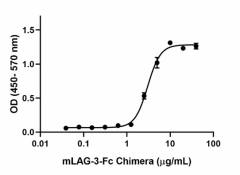
-

Recombinant Mouse LAG-3-Fc Chimera induces TNF-α production in mouse immature dendritic JAWII cells in a dose-dependent manner. The ED50 for this effect is 1 - 4 µg/mL. -

Stability Testing for Recombinant Mouse LAG-3-Fc Chimera. Recombinant Mouse LAG-3-Fc Chimera was aliquoted in PBS, pH 7 at 0.2 mg/mL. One aliquot was frozen and thawed four times (4x Freeze/Thaw) and compared to the control that was kept at 4°C (Control). The samples were tested for their ability to induce TNF-α production in mouse immature dendritic JAWII cells in a dose-dependent manner. The ED50 for this effect is 1 - 4 µg/mL.
Mouse LAG-3 is a type I transmembrane protein, identified initially in human activated NK cells and T cells. The LAG3 mouse and human genes are localized in chromosome 6 and 12, respectively, and are adjacent to the CD4 gene. LAG-3 is structurally similar to CD4, both have four extracellular immunoglobulin superfamily (IgSF)-like domains; nevertheless, both proteins share only 20% similarity at the amino acid level. LAG-3 expressed in the membrane forms dimers and this dimerization might be necessary to the interaction of LAG-3 and the MHC class II molecule. Soluble forms of LAG-3 have been described as the result of alternative splicing in CD4+ T cells and by proteolytic cleavage in the connecting peptide, that join the extracellular domains to the transmembrane domain, by ADAM10/17 metalloproteinases. It has been suggested that soluble LAG-3 weakens the differentiation of monocytes to macrophages and dendritic cells. Also, soluble LAG-3 may be useful as a prognostic biomarker in patients with active tuberculosis, since detection of LAG-3 in serum is associated with a favorable prognosis. Tumor infiltrating lymphocytes (TIL) express high levels of LAG-3 and PD-1 and both inhibitory receptors act synergistically to regulate T cell function and promote tumor immune escape.
Product DetailsProduct Details
- Source
- Mouse LAG-3, amino acid (Gly24-Leu442) (Accession #: Q61790) was expressed in 293E cells. The carboxy terminus contains a SR-IEGRMD-mIgG2a-Fc tag.
- Molecular Mass
- The 659 amino acid recombinant protein has a predicted molecular mass of approximately 72.4 kD. The DTT-reduced and non-reduced protein migrates at approximately 80 kD and 160 kD by SDS-PAGE, respectively. The predicted N-terminal amino acid is Gly.
- Purity
- >95%, as determined by Coomassie stained SDS-PAGE.
- Formulation
- 0.22 µm filtered protein solution is in PBS pH 7.2.
- Endotoxin Level
- Less than 0.1 EU per µg protein as determined by the LAL method.
- Concentration
- 10 and 25 µg sizes are bottled at 200 µg/mL. 100 µg size and larger sizes are lot-specific and bottled at the concentration indicated on the vial. To obtain lot-specific concentration and expiration, please enter the lot number in our Certificate of Analysis online tool.
- Storage & Handling
- Unopened vial can be stored between 2°C and 8°C for 1-2 weeks, at -20°C for six months, or at -70°C untill expiration date. For maximum results, quick spin vial prior to opening. The protein can be aliquoted and stored at -20°C to -70°C. Stock solutions can also be prepared at 50-100 µg/mL in appropriate sterile buffer, carrier protein such as 0.2-1% BSA or HSA can be added when preparing the stock solution. Aliquots can be stored between 2°C and 8°C for up to one week and stored at -20°C to -70°C for up to 3 months. Avoid repeated freeze/thaw cycles.
- Activity
- Mouse LAG-3-Fc chimera induces TNF-α production by mouse immature dendritic JAWSII cells in a dose-dependent manner. The ED50 for this effect is 1 – 4 µg/mL.
- Application
-
Bioassay
- Application Notes
-
BioLegend carrier-free recombinant proteins provided in liquid format are shipped on blue ice. Our comparison testing data indicates that when handled and stored as recommended, the liquid format has equal or better stability and shelf-life compared to commercially available lyophilized proteins after reconstitution. Our liquid proteins are verified in-house to maintain activity after shipping on blue ice and are backed by our 100% satisfaction guarantee. If you have any concerns, contact us at tech@biolegend.com.
Antigen Details
- Structure
- Homodimer
- Distribution
-
Regulatory T cells, activated T and NK cells, plasma cell subset, tumor infiltrating lymphocytes (TIL)
- Function
- Inhibits antigen-specific T cell activation; regulates activation, proliferation, and effector function in T cells.
- Interaction
- Binds to MHC class II, antigen-presenting cells, melamona cells, stromal cell, CD8 T cells.
- Ligand/Receptor
- FGL1, LSECtin, and Galectin 3
- Bioactivity
- Mouse LAG-3 induces TNF-α production by mouse immature dendritic JAWSII cells in a dose-dependent manner.
- Cell Type
- Antigen-presenting cells, Dendritic cells, Lymphocytes, Macrophages, NK cells, Plasma cells, T cells, Tregs
- Biology Area
- Immuno-Oncology, Immunology, Inhibitory Molecules
- Molecular Family
- CD Molecules, Immune Checkpoint Receptors, Soluble Receptors
- Antigen References
-
- Huard B, et al. 1997. Proc Natl Acad Sci U S A. 94:5744.
- Li N, et al. 2004. J. Immunol. 173:6806.
- Buisson S and Triebel F. 2005. Immunology. 114:369.
- Triebel F, et al. 2006. Cancer Lett. 235:147.
- Woo SR, et al. 2012. Cancer Res. 72:917.
- Andrews LP, et al. 2017. Immunol Rev. 276:80.
- Lino AC, et al. 2018. Immunity. 49:120.
- Gene ID
- 16768 View all products for this Gene ID
- UniProt
- View information about LAG-3 on UniProt.org
Related FAQs
- Why choose BioLegend recombinant proteins?
-
• Each lot of product is quality-tested for bioactivity as indicated on the data sheet.
• Greater than 95% Purity or higher, tested on every lot of product.
• 100% Satisfaction Guarantee for quality performance, stability, and consistency.
• Ready-to-use liquid format saves time and reduces challenges associated with reconstitution.
• Bulk and customization available. Contact us.
• Learn more about our Recombinant Proteins. - How does the activity of your recombinant proteins compare to competitors?
-
We quality control each and every lot of recombinant protein. Not only do we check its bioactivity, but we also compare it against other commercially available recombinant proteins. We make sure each recombinant protein’s activity is at least as good as or better than the competition’s. In order to provide you with the best possible product, we ensure that our testing process is rigorous and thorough. If you’re curious and eager to make the switch to BioLegend recombinants, contact your sales representative today!
- What is the specific activity or ED50 of my recombinant protein?
-
The specific activity range of the protein is indicated on the product datasheets. Because the exact activity values on a per unit basis can largely fluctuate depending on a number of factors, including the nature of the assay, cell density, age of cells/passage number, culture media used, and end user technique, the specific activity is best defined as a range and we guarantee the specific activity of all our lots will be within the range indicated on the datasheet. Please note this only applies to recombinants labeled for use in bioassays. ELISA standard recombinant proteins are not recommended for bioassay usage as they are not tested for these applications.
- Have your recombinants been tested for stability?
-
Our testing shows that the recombinant proteins are able to withstand room temperature for a week without losing activity. In addition the recombinant proteins were also found to withstand four cycles of freeze and thaw without losing activity.
- Does specific activity of a recombinant protein vary between lots?
-
Specific activity will vary for each lot and for the type of experiment that is done to validate it, but all passed lots will have activity within the established ED50 range for the product and we guarantee that our products will have lot-to-lot consistency. Please conduct an experiment-specific validation to find the optimal ED50 for your system.
- How do you convert activity as an ED50 in ng/ml to a specific activity in Units/mg?
-
Use formula Specific activity (Units/mg) = 10^6/ ED50 (ng/mL)

 Login / Register
Login / Register 





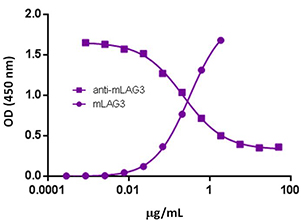
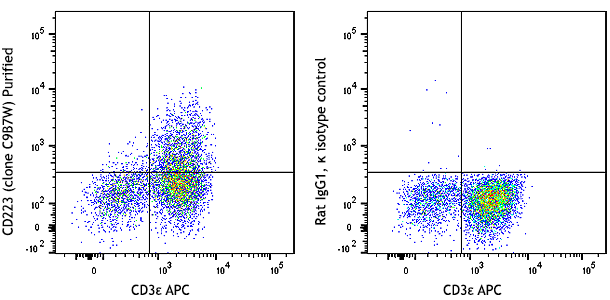
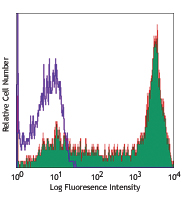
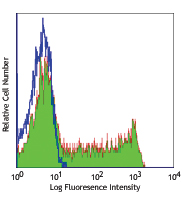



Follow Us